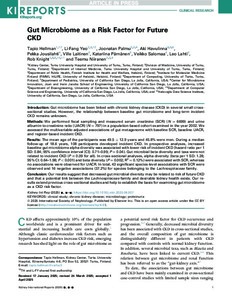Gut Microbiome as a Risk Factor for Future CKD
Hellman, Tapio; Yeo, Li-Fang; Palmu, Joonatan; Havulinna, Aki; Jousilahti, Pekka; Laitinen, Ville; Pärnänen, Katariina; Salomaa, Veikko; Lahti, Leo; Knight, Rob; Niiranen, Teemu
https://urn.fi/URN:NBN:fi-fe2025082790906
Tiivistelmä
Introduction: Gut microbiome has been linked with chronic kidney disease (CKD) in several small cross-sectional studies. However, the relationship between baseline gut microbiome and long-term incident CKD remains unknown.
Methods: We performed fecal sampling and measured serum creatinine (SCR) (N = 6699) and urine albumin-to-creatinine ratio (UACR) (N = 797) in a population-based cohort examined in the year 2002. We assessed the multivariable-adjusted associations of gut metagenome with baseline SCR, baseline UACR, and register-based incident CKD.
Results: The mean age of the participants was 49.5 ± 12.9 years and 45.8% were men. During a median follow-up of 18.6 years, 108 participants developed incident CKD. In prospective analyses, increased baseline gut microbiome alpha diversity was associated with lower risk of incident CKD (hazard ratio per 1 SD: 0.84; 95% confidence interval [CI]: 0.71–0.99; P = 0.04). Gut microbial beta diversity and taxa were not related to incident CKD (P ≥ 0.09 for all). In cross-sectional analyses, alpha diversity (beta per 1 SD: 1.28; 95% CI: 0.64–1.98; P < 0.001) and beta diversity (P = 0.002; R2 = 0.12%) were associated with SCR, whereas no associations were observed for UACR. In total, 43 significant species-level associations with SCR were observed and 16 negative associations (37.2%) for species belonging to the Lachnospiraceae family.
Conclusion: Our results suggest that decreased gut microbial diversity may be related to risk of future CKD and that a potential link between the Lachnospiraceae family and desirable kidney health exists. Our results extend previous cross-sectional studies and help to establish the basis for examining gut microbiome as a CKD risk factor.
Kokoelmat
- Rinnakkaistallenteet [27094]
